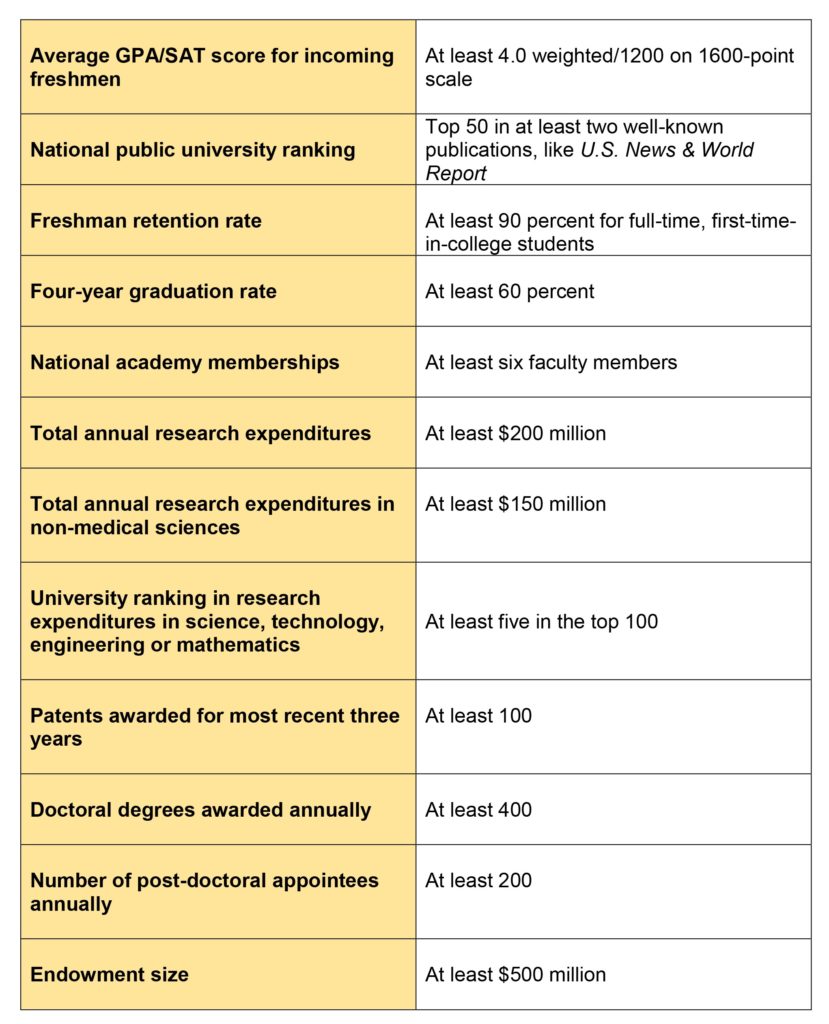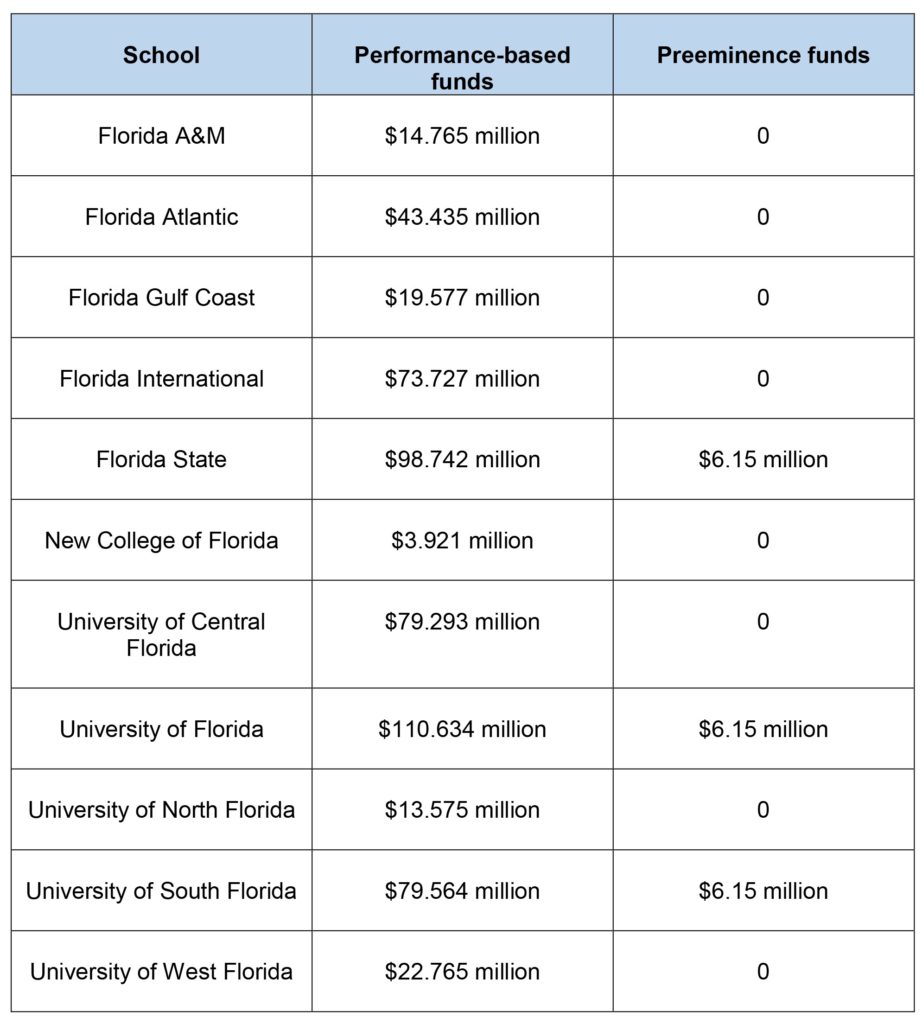
By Nancy McCann
When Pinellas County legislators led a move last spring to consolidate the three campuses of the USF system, their stated goal was simple:
They wanted St. Petersburg and Sarasota-Manatee to get some of the state “preeminence” money coming to Tampa.
During the discussions that followed on how to implement consolidation, some administrators and professors in Tampa have stressed that maintaining USF Tampa’s newly won status as a preeminent state research university is paramount.
One of them is USF system President Judy Genshaft.
“Strengthening Florida preeminent university status for the (unified) University of South Florida is absolutely, absolutely our No. 1 goal and everything else falls in place with preeminence,” she said at a USF system Board of Trustees meeting on Jan. 14.
But wait.
USF Tampa is getting $6.15 million in extra state funds in 2018-2019 for meeting the Legislature’s requirements for preeminence.
That’s a tiny fraction of the Tampa campus’ operating budget of $851 million.
And it’s small potatoes compared to the $79.6 million that Tampa is getting this year in what’s called performance-based funding. USF St. Petersburg’s share of that is about $8.3 million – which is more than Tampa’s preeminence funding.
Moreover, preeminence money is subject to the whims of the Legislature every year.
Under a working state budget proposed by the Florida House, USF Tampa’s share of preeminence money next year would be cut in half.
So why are so many influential leaders so keenly focused on “preeminence”?
The extra money is nice, university officials say, but the word “preeminent” carries a lot of weight with professors, administrators and prospective students.
That frustrates Ray Arsenault, a history professor and president of the USF St. Petersburg Faculty Senate.
“All they (Genshaft and some members of the Tampa administration) can see is metrics,” he told The Crow’s Nest earlier this year. “Their bottom line is (maintaining USF’s) preeminence in the state university system by meeting key metrics in student admissions and retention rates, research spending, size of endowment, and other academic yardsticks.
“The fixation on preeminence makes it harder for the (St. Petersburg) campus to serve non-traditional and minority students and let students change majors as they experiment and grow.
“A formulaic march to graduation,” Arsenault said, “is intellectually destructive.”
In February, the Tampa Faculty Senate voted overwhelmingly to oppose making St. Petersburg and Sarasota-Manatee full branch campuses because that “would threaten” Tampa’s newly won preeminence.
The senate did not mention performance-based funding.
However, when Tim Boaz, the Tampa Faculty Senate president, was asked last week about the sharp focus on preeminence while performance-based funding is significantly larger, he said both revenue sources are important.
“Leaders at USF are keenly focused on both preeminence funding and performance-based funding,” Boaz wrote in an email to The Crow’s Nest. “These are the two main ways in which the university can increase the amount of funding from the State of Florida and both are very important.
“‘Preeminence’ does carry with it a connotation of excellence or quality that enhances the reputation of the university which is also very desirable.”
Metrics and money
Preeminence was created by the Florida Legislature in 2013 to give extra funds to the state universities that meet at least 11 of 12 metrics – or yardsticks – that legislators established and re-examine each year.

To become a preeminent state research university, a school must meet 11 of these 12 metrics.
Emily Wunderlich | The Crow’s Nest
After consolidation, data from USF St. Petersburg and USF Sarasota-Manatee will be combined with Tampa’s when determining if the metrics have been met.
The preeminence metrics recognize research productivity and include: Having an annual research expenditure of at least $200 million; at least $150 million in annual research in non-medical sciences; at least 100 patents awarded in the most recent three years; at least 400 doctoral degrees awarded annually; and an endowment of at least $500 million.
The University of Florida and Florida State University were designated immediately as preeminent research universities, with UF meeting all 12 of the metrics and FSU meeting 11.
USF Tampa joined UF and FSU last summer as Florida’s third preeminent state research university, meeting 11 of the 12 metrics. It fell short on the endowment standard.
Performance-based funding, in place since 2014, has a different angle and centers on student productivity.

State universities in Florida are evaluated to determine “excellence or improvement”
based on one year’s data. These are the metrics.
Emily Wunderlich | The Crow’s Nest
Its 10 metrics include: Percentage of bachelor’s graduates who are employed and earning above $25,000 or continuing their education; median wages of bachelor’s graduates employed full time; percentage of bachelor’s degrees without excess hours; and percentage of undergraduates with a Pell Grant, money for students with financial need.
Two pots of money are combined each year for performance-based funding: the state’s contribution and institutional contributions from each university’s recurring budget.
The Board of Governors of the State University System establishes minimum thresholds for the universities to receive the two types of funds. The funding is determined by a point system based on the 10 performance-based metrics.
The USF system’s 2018-2019 performance-based funding award from the state’s contribution was about $7.7 million less than last year.
Appealing to students
As regional associate vice chancellor for administration and finance, David Everingham spends a lot of time poring over numbers.
“While preeminence may receive the most attention lately in the news, the Board of Trustees and leadership across the USF System have remained focused on all metrics for both PBF (performance-based funding) and preeminence,” he said in an email.
“I think the public hears more about preeminence these days since it was achieved by USF (Tampa) this year and because of accreditation consolidation, which will ultimately require the evaluation of consolidated data for all three campuses in achieving/maintaining the designation.”
Martin Tadlock, USF St. Petersburg’s regional chancellor, told The Crow’s Nest that the simple answer to why there is so much emphasis on preeminence is that people value rankings and designations.
“It’s not all about the money. Preeminence is a stamp from the state acknowledging the top-tier research institutions,” he said. “It’s appealing to students who are looking for institutions that are designated as exceptional. Initially, rankings and designations grab people’s attention.”
Tadlock said that preeminence also “leads to possible AAU (Association of American Universities) membership.”
Last year USF Tampa was awarded a chapter of Phi Beta Kappa – the nation’s oldest and most prestigious academic honors organization – and university leaders are working to join AAU next.
AAU is considered an elite group. AAU’s 62 public and private members are judged to be leaders in innovation, scholarship and contributions to society.
UF is the only Florida school on the list, which includes Princeton, Yale, Columbia, Stanford, Duke, Purdue, the University of Michigan, Georgia Tech and Texas A&M.
“Metrics measure efficiency and productivity but there’s always more discussion to be had,” Tadlock said.
“I’ve been saying since I’ve been here and I’m not wrong: Do the right thing and the numbers will follow.”
Performance-based funding and preeminence funding in 2018-2019
Each year, Florida’s 11 public universities receive extra funding based on their performance on 10 yardsticks, or metrics, established by the state. That is called “performance-based funding.”
Using mostly different yardsticks, universities that meet or exceed 11 of 12 metrics are also entitled to receive additional funding as “preeminent research universities.”
Only three schools got the preeminent designation this year.

Note: The University of Central Florida received $1.54 million as an “emerging preeminent university” because it met or exceeded seven of the 12 metrics.
Source: State university system
Emily Wunderlich | The Crow’s Nest




One thought on “Why all the fuss about ‘preeminence’?”